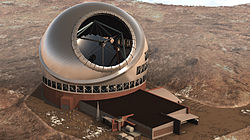
An extremely large telescope (ELT) is an astronomical observatory featuring an optical telescope with an aperture for its primary mirror from 20 metres up to 100 metres across, [1] [2] when discussing reflecting telescopes of optical wavelengths including ultraviolet (UV), visible, and near infrared wavelengths. Among many planned capabilities, extremely large telescopes are planned to increase the chance of finding Earth-like planets around other stars. [3] Telescopes for radio wavelengths can be much bigger physically, such as the 300 metres (330 yards) aperture fixed focus radio telescope of the Arecibo Observatory (now defunct). Freely steerable radio telescopes with diameters up to 100 metres (110 yards) have been in operation since the 1970s.
Contents
These telescopes have a number of features in common, in particular the use of a segmented primary mirror (similar to the existing Keck telescopes), and the use of high-order adaptive optics systems. [4] [5]
Although extremely large telescope designs are large, they can have smaller apertures than the aperture synthesis on many large optical interferometers. However, they may collect much more light, along with other advantages.







